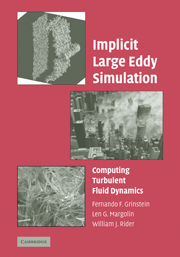Book contents
- Frontmatter
- Contents
- Preface
- List of Acronyms
- List of Contributors
- Introduction
- SECTION A MOTIVATION
- SECTION B CAPTURING PHYSICS WITH NUMERICS
- SECTION C VERIFICATION AND VALIDATION
- 7 Simulating Compressible Turbulent Flow with PPM
- 8 Vortex Dynamics and Transition to Turbulence in Free Shear Flows
- 9 Symmetry Bifurcation and Instabilities
- 10 Incompressible Wall-Bounded Flows
- 11 Compressible Turbulent Shear Flows
- 12 Turbulent Flow Simulations Using Vorticity Confinement
- 13 Rayleigh–Taylor and Richtmyer–Meshkov Mixing
- SECTION D FRONTIER FLOWS
- Index
- Plate section
9 - Symmetry Bifurcation and Instabilities
from SECTION C - VERIFICATION AND VALIDATION
Published online by Cambridge University Press: 08 January 2010
- Frontmatter
- Contents
- Preface
- List of Acronyms
- List of Contributors
- Introduction
- SECTION A MOTIVATION
- SECTION B CAPTURING PHYSICS WITH NUMERICS
- SECTION C VERIFICATION AND VALIDATION
- 7 Simulating Compressible Turbulent Flow with PPM
- 8 Vortex Dynamics and Transition to Turbulence in Free Shear Flows
- 9 Symmetry Bifurcation and Instabilities
- 10 Incompressible Wall-Bounded Flows
- 11 Compressible Turbulent Shear Flows
- 12 Turbulent Flow Simulations Using Vorticity Confinement
- 13 Rayleigh–Taylor and Richtmyer–Meshkov Mixing
- SECTION D FRONTIER FLOWS
- Index
- Plate section
Summary
Introduction
The importance of investigating nonlinear bifurcation phenomena in fluid mechanics lies in enabling a clearer understanding of hydrodynamic stability and the mechanism of laminar-to-turbulent flow transition. Bifurcation phenomena have been observed in a number of laboratory flows, with incompressible flow in sudden expansions being one of the classical examples. At certain Reynolds numbers, these flows present instabilities that may lead to bifurcation, unsteadiness, and chaos (Mullin 1986).
For example, the existence of symmetry-breaking bifurcation in suddenly expanded flows has been demonstrated (Chedron, Durst, and Whitelaw 1978; Fearn, Mullin, and Cliffe 1990). This is manifested as an asymmetric separation that occurs beyond a certain value of Reynolds number. Similarly, Mizushima et al. (Mizushima, Okamoto, and Yamaguchi 1996; Mizushima and Shiotani 2001) have conducted experimental investigations to extend suddenly expanded flows to suddenly expanded and contracted channel flow. They found that this type of geometry exhibits similar flow effects to the simpler suddenly expanded channel, with instabilities manifesting as asymmetric separation at Reynolds numbers within a critical range. In the experiments, the instabilities were triggered by geometrical imperfections and asymmetries in the inflow conditions upstream of the expansion. In a symmetric numerical setup, however, these asymmetries can only be generated by the numerical scheme and are associated with dissipation and dispersion properties of the numerical method employed. In the past, computational investigations have been conducted for unstable separated flows through sudden expansions (Alleborn et al. 1997; Drikakis 1997). In particular, numerical experiments by Patel and Drikakis (2004) using explicit (symmetric) solvers and different highresolution schemes were conducted to show that symmetry breaking depends solely on the details of the numerical scheme employed for the discretization of the advective terms.
Information
- Type
- Chapter
- Information
- Implicit Large Eddy SimulationComputing Turbulent Fluid Dynamics, pp. 292 - 300Publisher: Cambridge University PressPrint publication year: 2007
